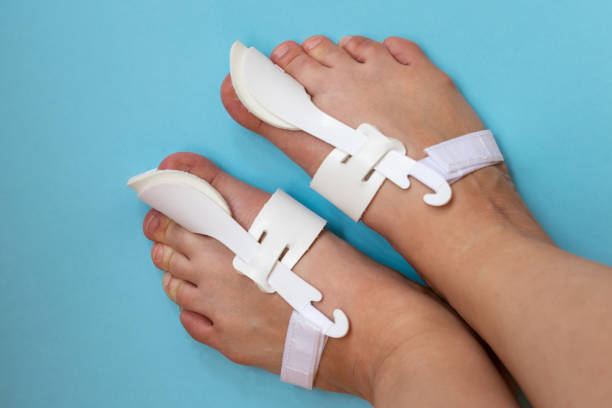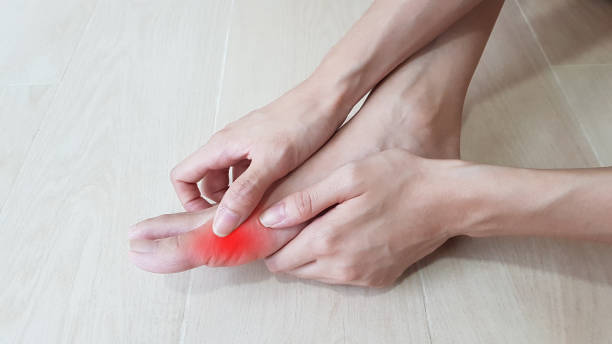Bunions can be severely painful, limiting activity and impacting self-esteem. Surgery is often the best solution for pain and to allow individuals to return to normal activities quickly.
Bunion surgery repositions the bones of your foot and corrects abnormal bone rotation, which is one of the main causes of bunion formation. To learn more about your bunion correction options, please schedule an appointment with Dr. Cowans!

Non-Surgical Options
If bunions are caught at an early stage, they may respond to nonsurgical treatment. But, as the bumps become more rigid and inflexible, these forms of care often prove less effective.
Over-the-counter anti-inflammatory drugs like ibuprofen can help reduce pain and swelling in the big toe joint. Orthotic shoe inserts, splints or protective pads are also good options that can help to keep the bunion from becoming more painful as it grows.
While it’s unclear what causes bunions to form, there are some contributing lifestyle factors that may increase your risk of developing them. These include being born with foot problems, having abnormal foot mechanics, or suffering from a foot injury or rheumatoid arthritis. It’s also believed that wearing tight-fitting shoes that put pressure on the toe box is a major cause of bunions.
If you suffer from a painful bunion, it’s important to find the best treatment for your needs. Talk with bunion clinic in Adelaide about your options today. We can provide a thorough exam, weight-bearing x-rays and other diagnostic tests to see if you’re a candidate for minimally invasive bunion surgery. Call us or request an appointment online to get started.
Orthotics
Changing your footwear to shoes that fit and don’t place pressure on the big toe can significantly reduce bunion pain. Shoes that are open-toed or wide around the toes provide more space, as do shoe inserts called orthotics. Your podiatrist may recommend these over-the-counter or custom-made orthotic shoe inserts, which help to control movement and support the foot to shift pressure away from the 1st metatarsal pad (ball of the big toe) and lessen the severity of bunions.
Your doctor may also recommend wearing a bunion correction Adelaide, which is a splint that straightens the big toe while you wear it. This can relieve pain but does not remove the bump. Ice packs can numb the area and reduce pain, as can nonsteroidal anti-inflammatory drugs (such as aspirin or ibuprofen). Whirlpool, ultrasound, and massage therapy can ease discomfort as well.
In severe cases, or if nonsurgical treatments haven’t provided relief, your doctor may recommend surgery to remove the bunion and realign the toe. The procedure is called bunionectomy, and it involves cutting, removing, or altering portions of the bone, ligaments, and tendons to relieve pressure on the big toe joint. Your doctor may use local anesthesia, a regional anesthesia (a popliteal block), or general anesthesia. An anesthesiologist will stay with you throughout the surgery to administer additional medications, if needed, and ensure that you are comfortable.

Physical Therapy
Bunion pain often starts at the critical metatarsophalangeal (MTP) joint, where the big toe joins the rest of the foot. This joint helps us bear and distribute weight and allows our feet to move in many different ways. When a bunion develops, the MTP joint shifts to accommodate it and becomes misshapen. This shift causes the big toe to point more toward other toes, and it puts stress on the joints and tissues around the toe. Over time, this imbalanced load can cause the MTP joint to swell and make it painful and difficult to walk.
If you try wide shoes, toe spacers, splints, and other treatments and still have pain, your doctor may recommend a surgical correction procedure. During surgery, your doctor cuts the bones in the area of the bunion to realign the joint and reduce the bump. He or she may also insert pins or screws to keep the bones straight, and he or she might shave off or remove excess bone tissue.
Following the procedure, you’ll need to remain non-weight bearing for a period of weeks to allow the bones to heal. Your doctor will probably apply a dressing and/or a cast to maintain the correct bone position, and you might use crutches or a knee-walker. Once the bones have healed, your doctor will let you start walking again in a pair of soft leather oxford shoes that best protect the new joint.
Surgery
The bunion is a painful condition caused by instability in the big toe joint. As the big toe shifts out of alignment, it causes pain from uneven weight-bearing and friction from footwear. This imbalanced pressure can also lead to an inflamed bursa (fluid-filled sac located around a joint) that causes more pain and swelling.
Bunion surgery is an option to reduce pain and correct the deformity of your big toe. Your foot and ankle surgeon will examine your feet and decide on the right surgical procedure for you.
There are several types of bunion surgery. The simplest is an osteotomy, which involves surgically cutting and realigning your big toe bone. This is performed in a hospital setting and may require you to stay off your foot for many weeks.
Another type of surgery is called a lapidoplasty, which involves placing a plate on the front part of your foot to hold the bones in place. This is a less invasive surgery than an osteotomy, but it may not correct the shape of your foot.
Medications can help minimize pain and swelling. Your doctor may prescribe over-the-counter anti-inflammatory medications, such as acetaminophen and ibuprofen, or recommend cortisone injections to treat the inflamed bursa. Pads to protect the area and separate your toes from rubbing can also reduce pain. You may also benefit from specialized shoe inserts, such as orthotics, that are specially made for your foot or custom-made by your podiatric surgeon.




